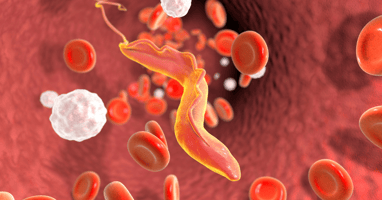In the world of structural biology, few tools have had as profound an impact as scFv16. This...
32 kDa UCP1: Sybody-LEGOBody strategy puts the journey from munitions workers to weight loss drug target in cryo-EM crosshairs
From the trenches of World War I to the ongoing battle against obesity, the story of UCP1 is as captivating as it is fascinating. Our journey starts in the munitions factories during the First World War, where workers exposed to a chemical known as 2,4-Dinitrophenol, or DNP, began to experience dramatic weight loss, elevated body temperatures, and excessive sweating. This phenomenon sparked interest in the medical community due to the potential applications for weight loss.

In fact, DNP was introduced as a weight-loss drug in the 1930s. However, its mainstream use was short-lived. DNP is extremely toxic and can lead to a number of severe side effects, including hyperthermia, tachycardia, sweating, and even death. By the late 1930s, these grave health risks led to DNP being declared unfit for human consumption, although it occasionally resurfaces in illicit usage for its weight-loss effects.
The role of DNP and UCP1 in uncoupling processes
The potency of DNP lies in its ability to make mitochondria more permeable to protons, leading to a significant uptick in metabolic rate and body temperature with a subsequent depletion of the body's fat and carbohydrate reserves. Normally, mitochondria use oxidative phosphorylation and the movement of protons across the mitochondrial membrane to generate ATP. However, DNP disrupts this process, acting as an uncoupling agent that enables proton transport across the mitochondrial membrane without contributing to ATP synthesis, causing the energy to be expended as heat. The link between DNP-mediated uncoupling and weight loss spurred interest in uncoupling protein 1 (UCP1) - whose name suggests its critical role in this very process - as a compelling target in the quest for effective weight management therapeutics.
Cryo-EM unveils DNP-UCP1 binding
Until recently, how DNP interacts with UCP1 was largely unknown. UCP1, a 32 kDa protein, is a member of the solute carrier (SLC) family, specifically belonging to the SLC25 mitochondrial carrier subfamily. Now a landmark study by Beijing researchers Yunlu Kang and Lei Chen has presented the structures of UCP1 in three distinct states: unbound, DNP-bound, and ATP-bound. These visualizations reveal the specific site at which DNP binds to UCP1, illuminating the molecular mechanics of the interaction and competitive inhibition.
The revealed structures not only deepen our understanding of UCP1's function and interaction with DNP but also pave the way for structure-based drug design. This breakthrough holds promise to guide the design of potent, yet safe, therapeutic drugs to combat metabolic disorders such as obesity.
The synergy of Sybodies and the LEGOBody approach
What is particularly fascinating about this study is the approach used to overcome the limitations associated with the small molecular weight of UCP1 (32 kDa) for structure determination by cryo-EM. Traditionally, cryo-EM has been considered more suitable for complexes larger than 50-60 kDa due to limitations in resolution for smaller proteins. As discussed in the MiTeGen Hottest Tweets in SBDD from June 2023, advancements in software like RELION might lower this molecular weight barrier. However, targets like UCP1 present a unique challenge due to their very small size.
To circumnavigate this issue, the researchers employed a technique that augmented the mass of UCP1. They identified a specific binder for UCP1 using the powerful Sybody library from Linkster Therapeutics, to serve as a fiducial marker. This Sybody was then subjected to an elaboration strategy for target-specific termed the "LEGOBody" approach. This method involves the use of a Fab fragment, which can bind to the scaffold of nanobodies including Sybodies. By attaching this Fab to the Sybody-bound UCP1, the researchers effectively increased the mass of the target protein complex, making it amenable to structure determination by cryo-EM.
Together, the synergy of the Sybody library and the LEGOBody strategy creates an especially potent combination for tackling small molecular weight targets. Sybody library has established a strong track record for very rapidly identifying binders that are specific to both the epitope and the conformation of a target. The beauty of the LEGOBody approach is that it is a universal method, ready to take such target-specific binders, amplify the molecular mass and improve visualization of the target.
The above strategy not only allowed for the successful determination of UCP1 structures in different states but also sets an important example for structure determination of other smaller proteins. These techniques will give others confidence for the study of small molecular weight targets, which were previously considered intractable by methods like cryo-EM.
Useful Links
1. Structural basis for the binding of DNP and purine nucleotides onto UCP1
2. Linkster Therapeutics Sybody platform
3. Cryo-EM structure determination of small proteins by nanobody-binding scaffolds (Legobodies)




